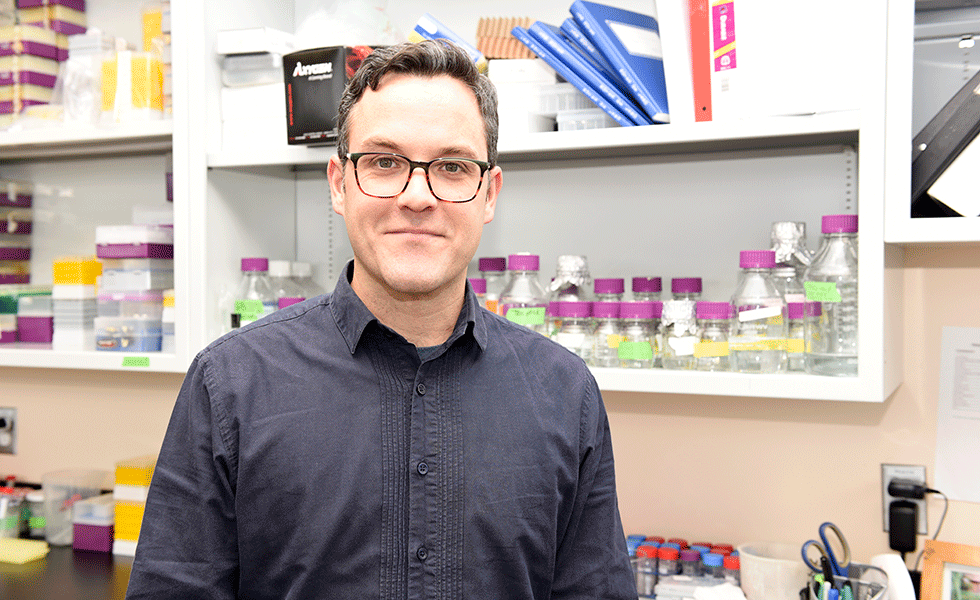
A team from the Montreal Clinical Research Institute (IRCM) wrote a new chapter in gene regulation by unearthing the function of about 200 proteins that have often flown under the radar of biologists: ribonucleic acid binding proteins (RBPs). The discovery could lead to new therapeutic targets for various diseases in which RBPs are known to be affected, such as different cancers and neurological disorders, including the fragile X syndrome, spinal muscular atrophy, amyotrophic lateral sclerosis (ALS) and frontotemporal dementia.
In the article published in the high impact factor journal Nature, Eric Lécuyer, researcher at the IRCM and a professor at the Faculty of Medicine at Université de Montréal, along with colleagues from four U.S teams, revealed that these RBPs are essential for cells to work properly and have important functions in the regulation of gene expression within different compartments of the cell.
“We noticed that RBPs are almost always located in a specific cellular subcompartment, which suggests that they play an active role in RNA regulation”, said Eric Lécuyer, “Some could, for example, have the function of transporting RNAs to specific locations in the cell. Others may react quickly to external stress, changing the RNA distribution in the cell and modifying the gene expression profile”. It is as if the RBPs act as the “cell’s FedEx system” he added, for simplicity. “Each RNA is routed to a different place in the cell because of an element, like a type of bar code included within its sequence, which could possibly be recognized by one or more RBPs.” Therefore, any dysfunction in the RBPs actions could lead to a wide range of diseases such as cancer, neurological and muscular disorders.
There could be between 1,500 to 2,000 different RBPs in humans. Understanding the functions of on a large scale has been a missing link until this recent paper. “The study of RNA regulation by RBPs has been totally overshadowed by the study of DNA regulation,” added Lécuyer. According to him, many of these proteins have been deeply preserved throughout evolution, from bacteria to humans: “This observation alone suggests that they are essential for cells to function properly.”
A concerted public data effort
To verify these facts, Eric Lécuyer and his colleagues characterized 200 RBPs as part of the ENCODE Project, a U.S. government initiative that follows the Human Genome Sequencing Project. The aim is to characterize each of the human genome’s functional elements, making this information available to the entire scientific community.
Each of the five groups participating in the project relied on a different approach to accumulate data on RBPs. The first laboratory determined the association between each RNA sequence and RBP in each cell. Another repeated the in vitro experiment, outside a cellular environment. The third group systematically blocked the production of each RBP in cultured cells and measured the impact of their absence on RNA expression. The fourth group investigated the impact of the DNA association of certain RBPs. Members of the Lécuyer team focused on the intracellular localization of RBPs.
In a five-year painstaking task, the team targeted each of the 200 RBPs with an antibody of its own to reveal the location of each protein in the cell. The group used cell fractionation to confirm information from the fluorescent assay.
In the future, they plan to continue this investigation by characterizing the location of a new collection of RBPs. “We have already done the work for another group of 250 proteins, and we now have antibodies that target a total of several hundred more,” he said.
About the study
The study is the result of a collaborative effort by a team from the IRCM and three U.S. universities. Xiaofeng Wang, Neal Cody, Louis Philip Benoit Bouvrette, Julie Bergalet and Eric Lécuyer, all from the IRCM’s RNA Biology Research Unit, were involved in the research. This study has more than 30 other authors from the University of California at San Diego, Massachusetts Institute of Technology and UConn Health’s Institute for Systems Genomics.
The research has received financial support from the National Human Genome Research Institute, Fonds de recherche du Québec – Santé (FRQS), Damon Runyon Cancer Research Foundation and National Institutes of Health.
Read full article published in Nature




